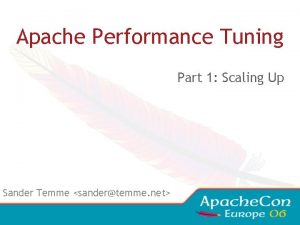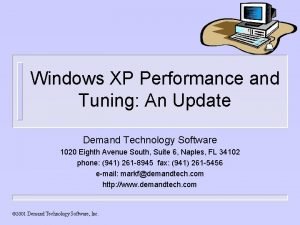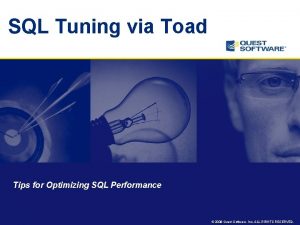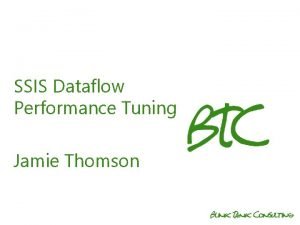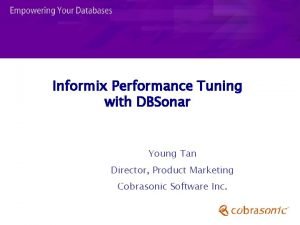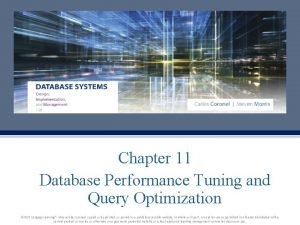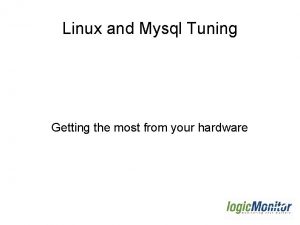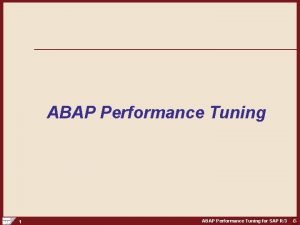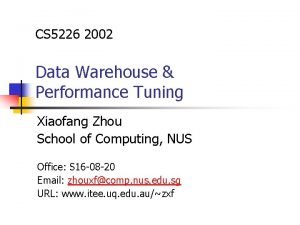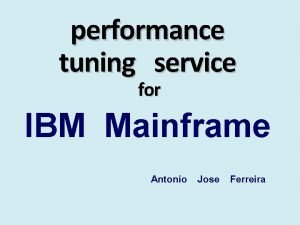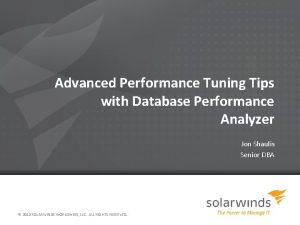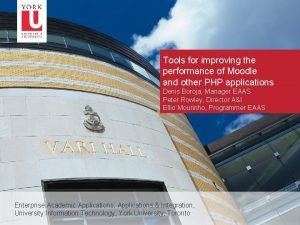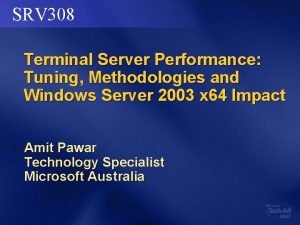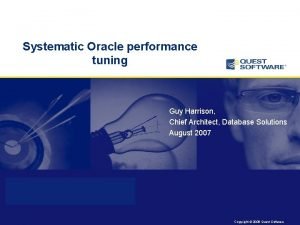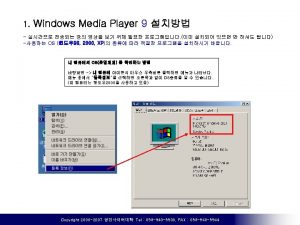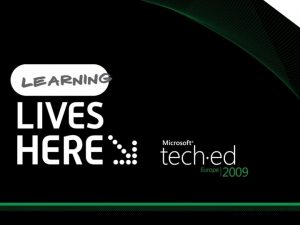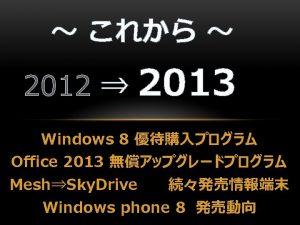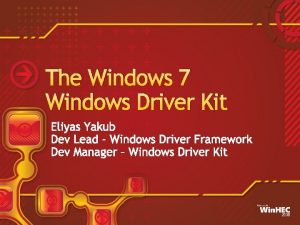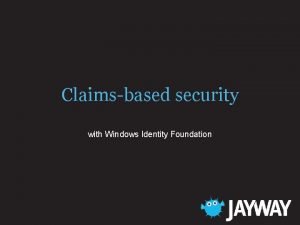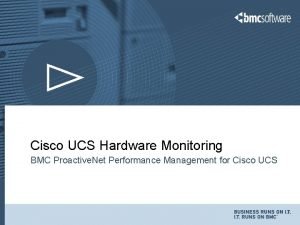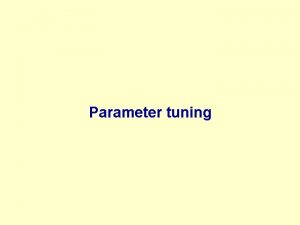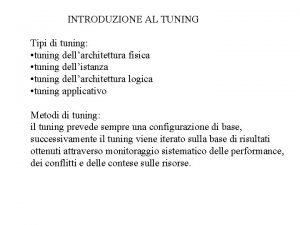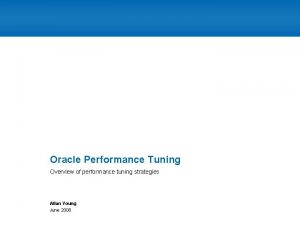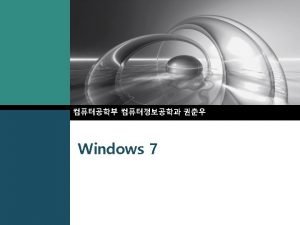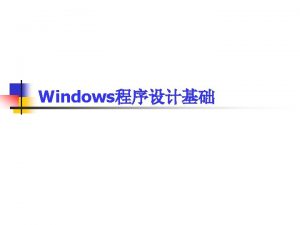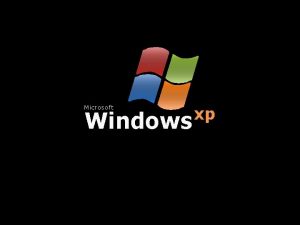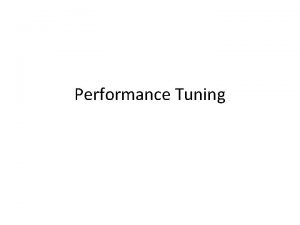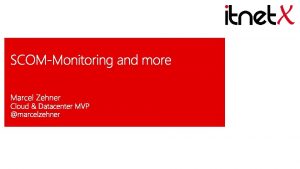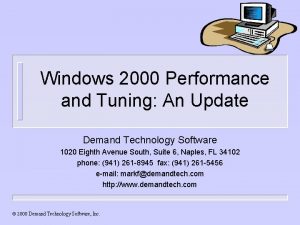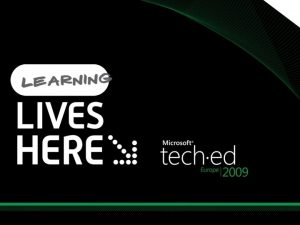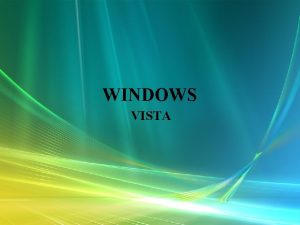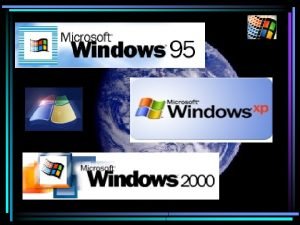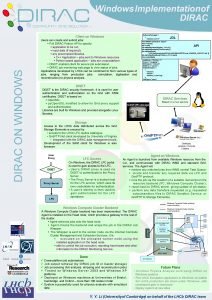Tuning Windows 7s Performance Ch 6 Monitoring Performance









































- Slides: 41

Tuning Windows 7's Performance Ch 6

Monitoring Performance

Performance Rating • Windows 7 adjusts itself to match the ability of the hardware – – Aero Theme v. Windows Basic Gaming features TV recording Video playback

Win. SAT: Windows System Assessment Tool • Start, PERF • Click "Performance Information and Tools" • Scores range from 1. 0 -7. 9 • Higher is better

Task Manager • Ctrl+Shift+Esc or Ctrl+Alt+Delete • Processes tab shows CPU and RAM each process is using • CPU stuck at 100% or Memory constantly increasing indicates a problem • You can terminate processes here

Task Manager • Performance tab • Physical Memory – Total: Amount of RAM installed – Cached: Contains recently used programs and documents, can be used for applications if necessary – Available: Physical RAM that is not being used – Free: Portion of the cache that does not contain useful information • These numbers are inaccurate and don't add up correctly (see links Ch 6 a & 6 b)

Task Manager • Kernel Memory – Paged: Mapped to virtual memory – Nonpaged: Must be in physical RAM only

Task Manager • System – Handles: objects (pointers) used by all processes – Threads: Components of processes that operate independently – Processes: Number of items in the Processes tab – Up Time – Commit (MB): Minimum and Maximum Page File size

Page File • When RAM is unavailable, Windows puts data on the hard disk in the Page File – Also called virtual memory • Virtual memory is much slower than RAM • Computers that use too much virtual memory run slowly and need more RAM

Signs of Inadequate RAM • Physical Memory Free is small, approaching zero – System is starving for RAM • Physical Memory Cached much less than half of Physical Memory Total – System will be somewhat slow, because Windows cannot use as much cache as it should

Resource Monitor • Start, MONITOR • Click "Resource Monitor"

Resource Monitor • Overview tab – Four categories of metrics: CPU, Disk, Network, Memory – Expand category sections with the little down-arrow in the bottom section

Resource Monitor • CPU tab – Shows handles and modules for each process

Resource Monitor • Memory tab – Details for each process – Very clear summary at the bottom – Hard Faults occur when the computer cannot find data in the RAM cache and must use virtual memory

Resource Monitor • Disk tab – Details about disk usage by each process

Resource Monitor • Network tab – Lists TCP Connections and Listening Ports!

Performance Monitor • Start, PERFORMANCE • Click "Performance Monitor" • Baffling complexity • Not required for desktop support • Useful for servers

Optimizing Startup

Ways to Speed Up Startup • Skip BIOS Checks • Reduce OS Choices Menu Timeout – Start, MSCONFIG, Boot tab • Use "No GUI Boot" – But it will hide some Blue Screen errors

Ways to Speed Up Startup • Upgrade Device Drivers • Use Automatic Logon – Bad for security • Configure Prefetcher

Optimizing Applications

Ways to Speed Up Applications • Add more RAM • Get a faster hard drive • Adjust Prefetching to preload applications • Update Device Drivers • Giving Priority to Programs – Start, ADVANCED SYSTEM – Click "View advanced system Settings" – In Performance group, click Settings – Click Advanced tab • Programs is the default setting

Ways to Speed Up Applications • Give it more priority in Task Manager – Right-click process

Optimizing the Hard Disk

Hard Drive Performance Specifications • Hard Drive Speed – Revolutions per minute – 7, 200 rpm is common, 10, 000 rpm is available • Hard Drive Cache – 8 to 16 MB is common, 32 MB is better • Time Specifications – Seek Time • Most commonly quoted; lower is better – Latency – Write time – Read time

Hard Drive Maintenance • Keep empty space on the drive – Clean off unneeded files – Uninstall programs you don't need • Check Disk for Errors • Defragment disk • Disable Compression and Encryption • Turn off Content Indexing

Making Hard Drives Faster Exotic Ideas • Use Write Caching – On by default anyway • Use NTFS file system, not FAT 16 or FAT 32 • Turn off 8. 3 Filename Creation • Disable Last Access Timestamp

Optimizing Virtual Memory

Ways to Speed Up Virtual Memory • Virtual memory uses a hard disk file to store temporary data when RAM is full – Also called "Paging" • Adjusting the Page File – Start, ADVANCED SYSTEM – Click "View advanced system Settings" – In Performance group, click Settings – Click Advanced tab – Click Change…

Ways to Speed Up Virtual Memory • Use the fastest physical disk for the Page file • Use the disk with the most free space for the Page file – Helpful because the Page file can automatically grow • Split the Page file across multiple physical disks

Maintaining Your Windows 7 System Ch 7

Checking the Hard Disk for Errors • In Hard Drive Properties • Can take a long time

Checking Disk Free Space • Computer window in Details view shows free space • Disk Cleanup – Start, CLEAN – Click "Disk Cleanup"

Defragmenting Your Hard Disk • Defragmenting a disk arranges the files on it neatly • Makes read and write faster • Does NOT create more free space • Windows 7 defragments disks automatically – You shouldn't have to defragment manually

Preparing for Trouble • System Restore automatically creates restore points for you, that contain the Registry, installed program files, and crucial system files – Every 24 hours – Before installing modern applications, patches, unsigned device drivers – Before restoring backed-up files – Before reverting to a previous configuration using System Restore

Creating a System Repair Disc • Start, REPAIR • Click "Create a System Repair disc" • Useful if you don't have a Windows 7 Install disc

Backing Up Your Files • Start, BACKUP • Click "Backup and Restore" • Use "Set up backup" to schedule regular document backups • Use "Create a system image" to back up the System drive

Create a System Image • Store the backup on: • Hard disk • DVDs • Network

Restoring From a System Image • If Windows 7 is still running – Open Recovery in Control Panel – Click "Advanced Recovery Methods" • If the boot loader still works – Press F 8 during startup – In Advanced Boot Options, select "Repair your computer" • Boot from a Windows 7 install disc or a system repair disc – Click "Repair your computer"

Updates and Patches • Click Start, UPDATE • Click "Windows Update"

Reading Event Viewer Logs • Start, EVE • Click "Event Viewer" • View, Customize, clear "Action Pane"
 Xampp performance tuning
Xampp performance tuning Windows xp tuning
Windows xp tuning Toad sql optimizer
Toad sql optimizer Walker performance tuning
Walker performance tuning Performance tuning in ssis
Performance tuning in ssis Apache performance tuning
Apache performance tuning Glusterfs slow write performance
Glusterfs slow write performance Navision sql performance tuning
Navision sql performance tuning Ssas performance tuning
Ssas performance tuning Informix performance tuning
Informix performance tuning Sql server 2005 performance
Sql server 2005 performance Database performance tuning and query optimization
Database performance tuning and query optimization Mysql huge pages
Mysql huge pages Abap performance tuning
Abap performance tuning Data warehouse performance tuning
Data warehouse performance tuning Sshfs performance
Sshfs performance Mainframe performance optimization
Mainframe performance optimization Solarwinds performance tuning
Solarwinds performance tuning Moodle york
Moodle york Terminal server performance tuning
Terminal server performance tuning Ibm maximo architecture diagram
Ibm maximo architecture diagram Performance tuning in oracle tutorial
Performance tuning in oracle tutorial Harrison performance and tuning
Harrison performance and tuning Windows communication foundation wcf performance
Windows communication foundation wcf performance Herramientas de movie maker
Herramientas de movie maker Windws update
Windws update Ipseq
Ipseq Windows media player 9 windows 7
Windows media player 9 windows 7 Setup windows xp virtual machine
Setup windows xp virtual machine Media player classic skins
Media player classic skins Xp mode windows 7
Xp mode windows 7 Live mail windows 7
Live mail windows 7 Windows mobile center windows 10
Windows mobile center windows 10 Windows driver kit windows 7
Windows driver kit windows 7 Windows identity foundation windows 10
Windows identity foundation windows 10 Windows movie maker 2012 download
Windows movie maker 2012 download Windows movie maker vs windows live movie maker
Windows movie maker vs windows live movie maker Fleet performance monitoring
Fleet performance monitoring Cisco ucs hardware monitoring
Cisco ucs hardware monitoring Control loop performance monitoring
Control loop performance monitoring Glassfish performance monitoring
Glassfish performance monitoring Siebel monitoring
Siebel monitoring
